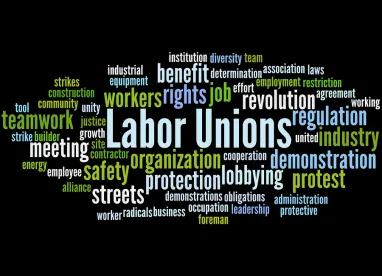On January 17, 2023, the U.S. Court of Appeals for the D.C. Circuit partially reversed and partially upheld a District Court decision that enjoined five rules promulgated by the National Labor Relations Board (“NLRB” or “Board”) in 2019 by the Trump-era Board (“2019 Rule”) to modify the Board’s representation election procedures. The 2019 Rule attempted to ease some of the “quickie election” rules established in 2014 by the Obama-era Board (“2014 Rule”). For a further discussion of the 2019 Rule, see “NLRB Issues Proposed Rule to Scale Back 2014 Expedited Election Rules.”
The D.C. Circuit held that because the Trump-era Board did not seek public notice and comment as required under the Administrative Procedure Act (“APA”) when issuing the 2019 Rule, “substantive” rule changes could not take effect, but “procedural” rule changes were valid under the procedural exception to the APA’s requirement for notice and comment.
What Got Scrapped and Why?
Under the APA, agencies must solicit and consider public comments before issuing or revising regulations; however, they need not do so for rules that only modify internal agency processes. In its analysis, the D.C. Circuit majority distinguished procedural rules as “primarily directed toward improving the efficient and effective operations of an agency” from substantive rules, which are rules that impose a “substantive burden,” “encode[] a substantive value judgment,” “trench[] on substantial private rights [or] interests,” or otherwise “alter[] the rights of interests of parties.” With these standards in mind, the D.C. Circuit found that three of the challenged provisions were substantive and, therefore, required a public notice and comment period.
Voter List
Under the existing rule, an employer must provide the petitioning union and the Regional Director with a list of employees included in the petitioned-for bargaining unit, including their job details and contact information, no later than two business days after a Stipulated Election Agreement is approved by the Regional Director or a Decision and Direction of Election is issued. The 2019 Rule extended that time from two business days to five business days. However, this change was deemed substantive and was found invalid. Thus, the 2014 rule remains in effect and employers continue to have two business days to provide the voter list.
Election Certification
The 2014 Rule permits Regional Directors to certify elections regardless of whether a request for review regarding the Decision and Direction of Election or objections to the conduct of the election have been filed. The 2019 Rule directed Regional Directors to wait until a request for review and/or objections are resolved, or the time to file a request or objections has passed, before certifying election results. The D.C. Circuit held this change was substantive and, thus, invalid. The 2014 Rule remains in effect and Regional Directors will continue to be able to certify election results regardless of whether a request for review or objections have been filed.
Election Observers
The 2019 Rule sought to require election observers for both the union and employer be a current member of the voting unit, or, if no such individual was available, a current non-supervisory employee. That change was deemed a substantive change and was also found invalid. Thus, the 2014 Rule regarding election observers remains in effect, which provides “[w]hen the election is conducted manually, any party may be represented by observers of its own selection, subject to such limitations as the regional director may prescribe.”
What Survived?
The D.C. Circuit upheld two of the “procedural” 2019 Rule changes because they were “principally ‘internal-housekeeping’ rules” that did not create a substantive burden on any parties’ rights or interests.
Litigating Eligibility, Unit Scope, and Supervisor Status Prior to an Election
The D.C. Circuit upheld the requirement under the 2019 Rule for parties to litigate issues relating to voter eligibility, unit scope, and supervisor status before an election. The 2014 Rule, on the other hand, permitted individuals with disputed eligibility to vote subject to challenge and for Regional Directors to resolve these disputes post-election.
20 Days Between a Decision and Direction of Election and an Election Date
The D.C. Circuit also upheld the 2019 Rule establishing a waiting period of 20 business days between the date a Regional Director issues a decision ordering an election and the scheduled election date to allow for the Board to rule on any requests for review that may be filed. Prior to the 2019 Rule, elections were to be conducted on the “earliest date practicable” following the issuance of the Decision and Direction of Election, which sometimes resulted in elections being scheduled within a mere 5 business days.
What’s Actually Changed?
Not much right now: The D.C. Circuit remanded the case back to the District Court to resolve other claims from the ALF-CIO not initially decided by the District Court and the NLRB will not give effect to the contested portions of the2019 Rule until the case is fully resolved and not subject to further appeal. In a predictable turn of events, the Biden-era Board voiced displeasure at the D.C. Circuit’s reinstatement of two of the five 2019 Rule changes. As of January 17, 2023, NLRB Chairman Lauren McFerran indicated that the Board will continue to administer election rules consistent with the prior District Court decision, citing that the appeal is not yet final because of the D.C. Circuit’s remand.
Accordingly, employers should continue to abide by the Board’s current representation election rules.
This decision sets a road map for the Biden-era Board to reverse these 2019 “procedural” rules without notice and comment. Ultimately, the Biden-era Board may make other “procedural” changes to the election rules to further speed up the election process.
We will continue to monitor for activity around the ever-changing election rules and provide the latest information as soon as it becomes available.




 />i
/>i

